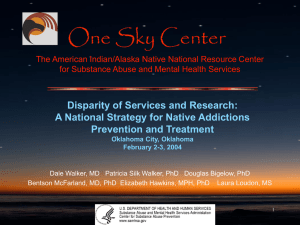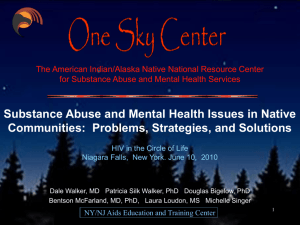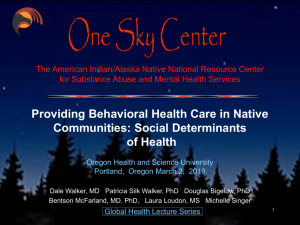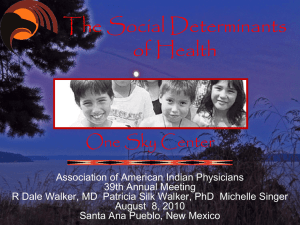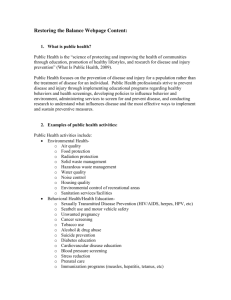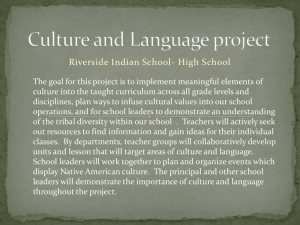Community Mobilization for Best Practice
advertisement
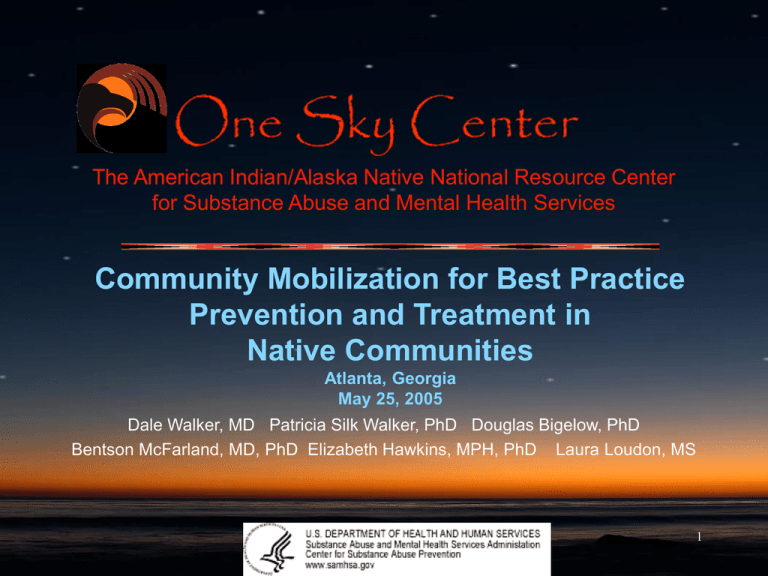
The American Indian/Alaska Native National Resource Center for Substance Abuse and Mental Health Services Community Mobilization for Best Practice Prevention and Treatment in Native Communities Atlanta, Georgia May 25, 2005 Dale Walker, MD Patricia Silk Walker, PhD Douglas Bigelow, PhD Bentson McFarland, MD, PhD Elizabeth Hawkins, MPH, PhD Laura Loudon, MS 1 For information, contact us at 503-494-3703 E-mail Dale Walker, MD onesky@ohsu.edu Or visit our website: www.oneskycenter.org 2 Overview • • • • • An Environmental Scan Behavioral Health Care Issues Fragmentation and Integration Introduction to One Sky Center Best Practice = Evidence-Based + Indigenous Knowledge 3 4 5 Health Problems 1. 2. 3. 4. 5. 6. Alcoholism 6X Tuberculosis 6X Diabetes 3.5 X Accidents 3X Physicians 72/100,000 (US 242) 60% Over 65 live in poverty (US 27%) American Indians • Have same health disorders as general population • Greater prevalence • Greater severity • Much less access to Tx • Cultural relevance more challenging • Social context disintegrated 7 Agencies Involved in B.H. Delivery 1. Indian Health Service (IHS) A. Mental Health B. Primary Health C. Alcoholism / Substance Abuse 2. Bureau of Indian Affairs (BIA) A. Education B. Vocational C. Social Services D. Police 3. Tribal Health 4. Urban Indian Health 5. State and Local Agencies 6. Federal Agencies: SAMHSA, VAMC 8 Disconnect Amongst Addictions, Mental Health, and Medicine • Professionals are undertrained in the other two domains • Patients are underdiagnosed • Patients are undertreated • These systems do not integrate well with social services 9 Difficulties of Program Integration • • • • • • • Separate funding streams and coverage gaps Agency turf issues Different treatment philosophies Different training philosophies Lack of resources Poor cross training Consumer and family barriers 10 Different goals Resource silos One size fits all Activity-driven How is it working? (Carl Bell, 7/03) 11 Culturally specific Best Practice Outcome driven Integrating resources We need Collaboration, Integration, and Synergy : Community Mobilization (Carl Bell, 7/03) 12 13 Program Goals • Promote and nurture effective and culturally appropriate prevention, treatment, and mental health services • Identify and disseminate evidence-based prevention, treatment, and mental health practices • Provide training and technical assistance • Help to expand capacity 14 One Sky Center Partners Alaska Native Tribal Health Consortium Northwest Portland Area Indian Health Board Tribal Colleges and Universities One Sky Center Eastern U.S. Tribal Consortium United American Indian Involvement National Indian Youth Leadership Project Jack Brown Adolescent Treatment Center 15 Projects • • • • • • • • Review SAMHSA portfolio: 134 projects Mental health liaison – SAMHSA/ IHS Medicaid, state, Indian funding Best practices consensus project National traffic safety – drivers training Suicide and substance abuse Suicide prevention Training and education 16 17 Definitions: Indigenous Knowledge • Is local knowledge unique to a given culture or society; it has its own theory, philosophy, scientific and logical validity, which is used as a basis for decision-making for all of life’s needs. 18 Definitions: Traditional Medicine • The sum total of health knowledge, skills and practices based upon theories, beliefs and experiences indigenous to different cultures…used in the maintenance of health. WHO 2002 19 Definitions: Evidence-based Practices • Interventions that show consistent scientific evidence of improving a person’s outcome of treatment and/or prevention in controlled settings. SAMHSA 2003 20 Definitions: Best Practices • Examples and cases that illustrate the use of community knowledge and science in developing cost effective and sustainable survival strategies to overcome a chronic illness. WHO 2002 21 World Conference on Science A partnership begins! • Recommended that scientific and indigenous knowledge be integrated in interdisciplinary projects dealing with culture, environment and chronic illness. 1999 Evidence based + community knowledge = best practice 22 ID Best Practice Best Practice Clinical/services Research Mainstream Practice Traditional Healing 23 Circle of Care Traditional Healers Primary Care A&D Programs Best Practices Child & Adolescent Programs Boarding Schools Colleges & Universities Prevention Programs Emergency Rooms 24 25 15 Effective Interventions for Adults • • • • • • • • • Cognitive/Behavioral Approaches Motivational Interventions Psychopharmacological Interventions Modified Therapeutic Communities Assertive Community Treatment Vocational Services Dual Recovery/Self-Help Programs Consumer Involvement Therapeutic Relationships 26 Effective Interventions for Youth • • • • • • Family Therapy Case Management Therapeutic Communities Community Reinforcement Circles of Care Motivational Enhancement 27 Community Mobilization Partnered Collaboration Grassroots Groups Community-Based Organizations Research-Education-Treatment 28 29 20 30 31
